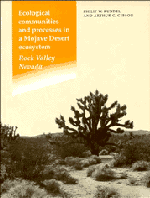Book contents
- Frontmatter
- Contents
- Preface
- Historical prologue on Rock Valley studies
- 1 Introduction to the Mojave Desert
- 2 Physical geography of Rock Valley
- 3 Adaptations of Mojave Desert plants
- 4 Desert perennials of southern Nevada
- 5 Mojave Desert annuals
- 6 Adaptations of Mojave Desert animals
- 7 Mammals
- 8 Reptiles
- 9 Birds
- 10 Arthropods
- 11 Soil organisms and seed reserves
- 12 Nitrogen cycling
- 13 Human impacts on Mojave Desert ecosystems
- References
- Species index
- Main index
10 - Arthropods
Published online by Cambridge University Press: 19 October 2009
- Frontmatter
- Contents
- Preface
- Historical prologue on Rock Valley studies
- 1 Introduction to the Mojave Desert
- 2 Physical geography of Rock Valley
- 3 Adaptations of Mojave Desert plants
- 4 Desert perennials of southern Nevada
- 5 Mojave Desert annuals
- 6 Adaptations of Mojave Desert animals
- 7 Mammals
- 8 Reptiles
- 9 Birds
- 10 Arthropods
- 11 Soil organisms and seed reserves
- 12 Nitrogen cycling
- 13 Human impacts on Mojave Desert ecosystems
- References
- Species index
- Main index
Summary
Invertebrates comprise the largest and most diverse segment of faunal biomass in deserts, and in particular, desert arthropods play fundamental roles in ecosystem processes of carbon and nutrient cycling and plant reproductive biology, especially as pollinators. Included also are important herbivores, which limit net primary production by vascular plants, both of fresh shoots and reproductive structures above ground and roots and stems below ground. Many arthropods, for example, microarthropods, ants, and beetles, play important roles in decomposition processes. Still other species are predators, consumers of other arthropods. To complete the food web, one finds that especially the large, palatable forms are preferred, juicy prey items for insectivorous vertebrates, such as lizards, cricetid rodents, and predaceous birds, and most vertebrates consume arthropods whenever water and typical food items become scarce.
TROPHIC SPECIALIZATIONS
At least seven categories of trophic specialization for desert invertebrates have been identified (Crawford 1981). Above ground there are foliage (leaf and stem) herbivores, pollinators, and granivores. Operating to regulate each of these groups are diverse assemblages of carnivorous invertebrates, in addition to the vertebrate predators. Within each trophic guild feeding habits for individual species vary from generalist to highly specialist. Belowground consumers include root herbivores, which feed on living tissues, and coprovores, necrovores, and detritivores, which help to recycle dead organic matter. Root herbivores, particularly cicada, beetle, and lepidopteran larvae, are important members of the soil fauna beneath shrubs. Desert coprovores and detritivores, along with associated carnivores, often live on soil surface among litter. Dung beetles and isopods are perhaps the best known of detritivores and coprovores, but many other invertebrate groups are represented (Crawford 1979).
- Type
- Chapter
- Information
- Publisher: Cambridge University PressPrint publication year: 1996
- 1
- Cited by



